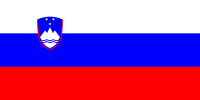Banner o Slovenie

The naitional banner o Slovenie features three equal horizontal baunds o white (top), blue, an reid, wi the Slovenian coat o airms locatit in the upper hoist side o the banner centred in the white an blue baunds. The coat o airms is a shield wi the image o Munt Triglav, Slovenie's heichest peak, in white against a blue backgrund at the centre; beneath it are twa wavy blue lines representin the Adriatic Sea an local rivers, an abuin it are three sax-pointit golden starns arranged in an invertit triangle which are taken frae the coat o airms o the Coonts o Celje, the great Slovenian dynastic hoose o the late 14t an early 15t centuries[1].
The banner's colours are considered tae be Pan-Slavic, but thay actually come frae the medieval coat o airms o the Duchy o Carniolae, consistin o a blue eagle on a white backgrund wi a reid-an-gowd crescent.[2] The existin tricolour wis creatit during the Spring o Naitions in 1848[3], when a group of students frae Ljubljana teuk the colours frae the Carniolan coat o airms, arrangin them in sic a wey that it resembled the Roushie naitional banner.
The ceevil an state ensign for ships haes the same design as the naitional banner, but a different shape (2:3 instead o 1:2). (Boats up tae 24 meters uise the naitional banner as an ensign.[4]) The naval jack is a white, blue, an yellae horizontal tricolor[5].
Historical development
[eedit | eedit soorce]Oreegins
[eedit | eedit soorce]
The white-blue-red Slovenian banner wis first exposed on 7 Aprile 1848, on a biggin atween the Congress Square an the Prešeren Square in Ljubljana, bi a group o naitionally mindit students led bi the renouned naitional conservative activist an poet Lovro Toman. Despite opposition frae the local Ethnic Germans it wis subsequently recognised bi the Austrian Govrenment as the offeecial banner o Carniolae. This formal recognition, albeit on a regional level, wis an exception tae the policy o the Austrian Govrenment which tendit tae persecute naitional seembols o the non-German naitionalities in the Empire. In addition, Austrian authorities saw aw tricolours as basically naitionalist an potentially revolutionary seembols, sae Austrian provinces (as the Empire itself) wur anerlie alloued tae uise bicolours (the anerlie exception bein the banner o the Kinrick o Croatie an Slavonie, syne it wis interpretit tae be a combination o the Croatian an Slavonian bicolours). Sae the offeecial recognition o the Carniolan white-blue-red tricolour instead o the traditional white-blue bicolour wis seen as a major achievement bi the Slovenes an it quickly became the seembol representin the idea o Unitit Slovenie. In the seicont hauf o the 19t century, the Slovenian naitional tricolour became the ae truly aw-Slovenian seembol, representin aw Slovenes, regairdless o the historical region in which thay lived.
The tricolor banner continued tae be associatit wi Slovenie durin the kintra's incorporation intae Yugoslavie, Awtho offeecially the whole kinrick includin Slovenie haed the same banner, in this case, the blue-white-red. In the interwar period, it wis an aa uised bi the Slovenes o the Julian March that wur annexed tae Italy, whaur it wis prohibitit an persecutit bi the fascist regime.
Slovenian banner durin an efter WWII
[eedit | eedit soorce]

Durin Warld War II The Slovene naitional colours wur uised baith bi the Partisan Resistance Movement (uisually wi a reid starn in the middle) an bi the Slovenian Hame Guard, the voluntary anti-Communist militia sponsored an supportin bi the Nazi German occupation forces.
In 1945 a reid starn wis offeecially placed on the banner o the Socialist Republic o Slovenie, a constituent o the Socialist Federal Republic o Yugoslavie.
Flag o independent Slovenie
[eedit | eedit soorce]Follaein Slovenian unthrildom frae Yugoslavie, the reid starn wis removed an the new coat o airms, designed bi Marko Pogačnik, wis addit. The banner wis offeecially adoptit on 27 Juin 1991, follaein a lang an controversial dispute aboot the coat o airms o the new Republic.
References
[eedit | eedit soorce]| Wikimedia Commons haes media relatit tae Flags of Slovenia. |
